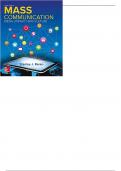, Chapter 1: Mass Communication, Culture, and Media Literacy
Chapter 1: Mass Communication, Culture, and
Media Literacy
Test Questions
Multiple-Choice Questions
1. Communication is best defined as
a. the transmission of a message from a receiver to a source.
b. conversation between two or a few people.
c. the process of creating shared meaning.
d. the product of large media industries.
Answer: c
Bloom’s level: Remember
2. Feedback is
a. the response to a given communication.
b. distortion typically attributed to electronic equipment.
c. sometimes present in communication.
d. rarely present in communication.
Answer: a
Bloom’s level: Remember
3. Communication between two or a few people is
a. mass communication.
b. feedback.
c. interpersonal communication.
d. reciprocal communication.
Answer: c
Bloom’s level: Remember
4. When messages are transformed into an understandable sign and symbol system by a
participant in the communication process, _____________ is said to have occurred.
a. noise
b. encoding
c. decoding
d. feedback
Answer: b
Bloom’s level: Remember
5. When signs and symbols are interpreted by a participant in the communication process,
_____________ is said to have occurred.
a. noise
b. encoding
c. decoding
d. feedback
Answer: c
Baran: Introduction to Mass Communication: Media Literacy and Culture, 9e TB-1 | 1
© 2017 by McGraw-Hill Education. This is proprietary material solely for authorized instructor use. Not authorized for sale or
distribution in any manner. This document may not be copied, scanned, duplicated, forwarded, distributed, or posted on a website, in
whole or part.
, Chapter 1: Mass Communication, Culture, and Media Literacy
Bloom’s level: Remember
6. Anything that interferes with successful communication is said to be
a. noise.
b. encoding.
c. decoding.
d. feedback.
Answer: a
Bloom’s level: Remember
7. In communication, the means by which messages are carried is
a. the feedback loop.
b. encoding.
c. decoding.
d. the medium.
Answer: d
Bloom’s level: Remember
8. The process of creating shared meaning between the mass media and their audiences is
a. mass communication.
b. feedback.
c. interpersonal communication.
d. encoding.
Answer: a
Bloom’s level: Remember
9. In mass communication, feedback is typically
a. instant and direct.
b. quite powerful.
c. absent.
d. delayed and inferential.
Answer: d
Bloom’s level: Understand
10. Large, hierarchically structured organizations are typical of
a. mass communication.
b. feedback.
c. interpersonal communication.
d. noise.
Answer: a
Bloom’s level: Understand
11. Ongoing and reciprocal messages are characteristic of
a. mass communication.
b. feedback.
c. interpersonal communication.
d. noise.
Answer: c
Bloom’s level: Understand
Baran: Introduction to Mass Communication: Media Literacy and Culture, 9e TB-1 | 2
© 2017 by McGraw-Hill Education. This is proprietary material solely for authorized instructor use. Not authorized for sale or
distribution in any manner. This document may not be copied, scanned, duplicated, forwarded, distributed, or posted on a website, in
whole or part.
, Chapter 1: Mass Communication, Culture, and Media Literacy
12. “Communication is a symbolic process whereby reality is produced, maintained, repaired, and
transformed” is
a. the cultural definition of communication.
b. a sophisticated definition of feedback.
c. interpersonal communication when it works well.
d. the biological definition of communication.
Answer: a
Blooms level: Remember
13. The communication scholar credited with developing the cultural definition of communication
is
a. James Carey.
b. Marshall McLuhan.
c. Wilbur Schramm.
d. Harold Lasswell.
Answer: a
Bloom’s level: Remember
14. Culture is
a. opera, theater, and symphonic music.
b. communication between two or a few people.
c. the learned behavior of members of a given social group.
d. the improvement of public tastes.
Answer: c
Bloom’s level: Remember
15. The culture that seems to hold sway with the majority of a given people is the
a. primary culture.
b. bounded culture.
c. dominant culture.
d. transformed culture.
Answer: c
Bloom’s level: Remember
16. Groups with specific but not dominant cultures that exist as part of those larger cultures are
a. secondary cultures.
b. bounded cultures.
c. minority cultures.
d. transformed cultures.
Answer: b
Bloom’s level: Remember
17. Culture is constructed and maintained
a. through the mass media.
b. through feedback.
c. through encoding and decoding.
d. through communication.
Answer: d
Bloom’s level: Remember
Baran: Introduction to Mass Communication: Media Literacy and Culture, 9e TB-1 | 3
© 2017 by McGraw-Hill Education. This is proprietary material solely for authorized instructor use. Not authorized for sale or
distribution in any manner. This document may not be copied, scanned, duplicated, forwarded, distributed, or posted on a website, in
whole or part.




